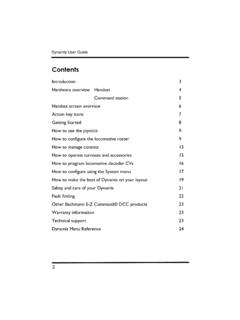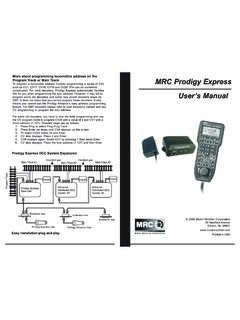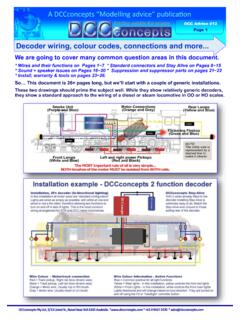Transcription of FINE TUNING LOCOMOTIVE SPEED - DCC - CMRCI
1 Ver: 21 June 2017 fine TUNING LOCOMOTIVE SPEED - DCC The steps for fine TUNING LOCOMOTIVE SPEED in a DCC environment are as follows (applicable CVs are listed and described in the table that follows). BEFORE YOU START: Make every effort to determine the table of Configuration Values (CV) for the decoder installed in the loco. This should have come with the loco/ decoder module as a sheet of values. There were originally 255 CVs defined by NMRA, however the number has increased to potentially 4096 and more. If the CVs are not available, interrogate the decoder on a programming track to find the Manufacturer ID (CV8) and Manufacturer Version No (CV7).
2 Once these values are known, use an internet search to establish the CVs used in the particular decoder , their function, and the range of values that are available for each CV. (Having the list of applicable CVs is very useful because not all CVs are invoked by all manufacturers, unless they are specified as required by the NMRA. Only eight CVs are classified as mandatory or strongly recommended. The rest are either optional but specific to a particular function, or available for a manufacturer to use for any particular function. Some are reserved for future use by NMRA, while the ranges 47-64 and 112-256 are available to manufacturers.)
3 Some of these ( CV116 and CV117 for NCE s decoders) may be used for motor control functions, so all CVs for the particular decoder should be investigated for possible fine TUNING application.) Make sure the loco is well maintained, clean and warm from running. Turn off any momentum (set CV3 and CV4 to 0) as well as any momentum adjustment (set CV23 and CV24 to 0). If the decoder has one or more of the functions such as Kick Start (CV65), Dither or Torque Compensation (CVs vary by manufacturer), turn them off (set the appropriate CV to 0). Do as much fine TUNING as you can with SPEED settings or SPEED table before making specific adjustments that might help the loco to get moving.
4 FIRST Determine whether a SPEED table is available in the decoder (CVs 67-94). If not, SPEED adjustment is only available through CV2-6. Ensure Vmid (CV6) is higher than Vstart (CV2) and lower than Vhigh (CV5). Play with Vstart to get the loco to keep running at SPEED step 1. Do this by increasing SPEED then backing down to SPEED step 1 to ensure the loco still creeps along. In some decoders ( Tsunami) CVs 5 and 6 are not available, so a SPEED table must be used. If a SPEED table is available, and you wish to use it, perform the same adjustments using CVs 67-94. Put the decoder in 28/128 mode by setting Bit 4 in CV29 to ON ( ensure a value of 16 is included in the CV29 value), set SPEED step 1 (CV67) to 0 and SPEED step 28 (CV94) to 255.
5 Make the SPEED table linear. Run the loco and determine at which SPEED step it will continue running. Put this value in SPEED step 1 and adjust the rest of the SPEED table accordingly. Ver: 21 June 2017 (Note that a SPEED table may not be appropriate for all locos, and may be an unnecessary complication. Operation of a shunter, say, may require that the earlier SPEED steps increase SPEED very little, while higher SPEED steps boost SPEED quickly for long transits. But a mainline unit may be quite realistic with fewer variations between the SPEED steps.) NEXT If the loco is still not functioning as desired on startup and at very slow SPEED , check to see if Kick Start, Dithering or Torque Compensation is available.
6 Kick Start is optionally prescribed for CV65, and provides extra voltage when moving from a stopped state to SPEED step 1. Kick Start only works at this point in the operation to overcome stiction. If Kick Start is available (not all decoders allow it, and it may only be available when SPEED table is off), then adjust Kick Start so that moving from a stopped position to SPEED step 1 actually starts the loco. Dithering is a manufacturer specific function so check the CV table to see which CVs may be applicable. The values will be included in the manufacturer usable ranges. It was originally introduced by TCS for use on high frequency (silent running) decoders using CVs 56 and 57.
7 Dithering, when used, applies extra short bursts of voltage at programmable frequency to make slow SPEED operation smooth. It works for about the first 20% of the SPEED table whereas Kick Start only operates when transiting from a stopped position to SPEED step 1. Some decoders allow both Kick Start and Dithering. It is personal choice as to which, if either, is used. If neither Kick Start nor Dithering is available, other functions may be invoked such as torque compensation. Check the CV table for options. NCE refers to torque compensation rather than dithering. OTHER ADJUSTMENTS Acceleration and Deceleration can be adjusted for more realistic operation if desired, and is sometimes referred to as momentum.
8 Two pairs of CVs have been specified by NMRA CV3 and 4, and CV23 and 24. The latter pair are referred to as acceleration/deceleration adjustment . The values applied to CV3 and CV4 determine the length of delay between SPEED steps as the loco accelerates (or decelerates) to reach the commanded SPEED . This means, if a command station has the ability to instantly demand full throttle, the loco moves up through the SPEED steps at a specified rate rather than instantly jumping to full SPEED . The value entered into CV3 and CV4 multiply the decoder s default delay period. NMRA specifies a default setting equivalent to seconds per SPEED step in 28 step mode.
9 Entering a value of 1 means the loco would reach full SPEED in just under a second. A value of 10 increases this delay to seconds per SPEED step, and the loco reaches full SPEED in about 9 seconds. Higher values are impractical for smaller, congested layouts. Useful numbers for CV3 and CV4 are from 5-10. Ver: 21 June 2017 CVs 23 and 24 are optional parameters that can be used to further modify momentum, and were specified by NMRA anticipating additional momentum adjustment for heavy loads or when locos are in a consist. The settings add to or subtract from the values in CV3 and 4 by a value defined similarly to those for CV3 and 4.
10 They are rarely needed and in practice are not available in an NCE command environment when using consists. TABLE OF CVs APPLICABLE TO SPEED OPERATION VALUE TITLE REQUIRED BY NMRA? DESCRIPTION 02 Vstart required Used in conjunction with Kick Start (CV65) or, if available, Dithering or Torque Compensation to ensure smooth starting. When set to zero no voltage is applied, when set to 255 maximum voltage is available. Useful range 1-100. 03 Acceleration rate required Causes short delay between SPEED steps as SPEED accelerates. NMRA specifies .032 seconds per value between SPEED steps. Other decoders may use different values so check the CV sheet.






